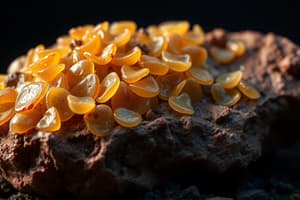Podcast
Questions and Answers
What property of light determines its color?
What property of light determines its color?
- Frequency (correct)
- Polarization
- Amplitude
- Intensity
Which of the following properties of light refers to the amount of light per unit area?
Which of the following properties of light refers to the amount of light per unit area?
- Intensity (correct)
- Polarization
- Wavelength
- Frequency
What type of waves are sound waves?
What type of waves are sound waves?
- Electromagnetic
- Transverse
- Mechanical
- Longitudinal (correct)
Which topic is closely related to adolescence in the article?
Which topic is closely related to adolescence in the article?
What determines the pitch of light?
What determines the pitch of light?
Which property of light refers to the orientation of light waves?
Which property of light refers to the orientation of light waves?
Which property of sound directly affects pitch?
Which property of sound directly affects pitch?
What property of sound affects loudness?
What property of sound affects loudness?
How does sexual reproduction differ from asexual reproduction?
How does sexual reproduction differ from asexual reproduction?
What process involves the splitting of an organism into two identical halves?
What process involves the splitting of an organism into two identical halves?
What significant chemical effects can electric current have?
What significant chemical effects can electric current have?
Which characteristic is NOT typically associated with adolescence?
Which characteristic is NOT typically associated with adolescence?
Study Notes
Science Topics: A Broad Overview
The field of science is vast and diverse, covering many different disciplines and areas of study. This article will explore four key science topics: light, sound, reproduction in animals, and chemical effects of electric currents. Additionally, we'll touch upon adolescence, which while not strictly a scientific topic, is an aspect of biology closely related to reproduction.
Light
Light is electromagnetic radiation within a certain portion of the electromagnetic spectrum. It is essential for all life on earth, providing energy for photosynthesis in plants and serving as a source of information for organisms through vision. Light has both particle and wave properties, exhibiting properties such as reflection, refraction, and diffraction.
Properties of Light
There are several fundamental properties of light, including:
- Wavelength: Determines color; shorter wavelengths correspond to blue light, longer ones to red light.
- Frequency: Measured in Hertz, it determines the pitch of light.
- Intensity: Amount of light per unit area.
- Polarization: Orientation of light waves.
Sound
Sound is longitudinal pressure waves in air, water, or other materials that travel away from their point of origin. It is generated by vibrating objects and can propagate through various mediums.
Properties of Sound
Some important features of sound include:
- Frequency: Directly affects pitch, with higher frequencies resulting in higher pitches.
- Amplitude: Affects loudness, with larger amplitudes producing louder sounds.
- Speed: Differences in speed can cause sound to arrive at different times, creating echoes or delaying aftershocks.
Reproduction in Animals
Reproduction in animals involves two main processes: sexually and asexually. Sexual reproduction occurs when parents combine their genetic material, and offspring inherit traits from both parents. Asexual reproduction, on the other hand, does not involve combining genetic material, and offspring are produced from a single individual.
Sexual Reproduction
Sexual reproduction is a complex process involving both males and females. In mammals, for example, fertilization occurs when a sperm penetrates and fuses with an ovum during sexual intercourse.
Asexual Reproduction
Asexual reproduction can occur through several methods, including:
- Budding: Portion of body breaks off and develops into a new organism.
- Binary fission: Organism splits into two identical halves.
- Fragmentation: Organism breaks apart into smaller pieces, each of which can develop into a new organism.
Chemical Effects of Electric Current
Electric current flows through a conductor when an electric field is applied. This flow of electrons can have significant chemical effects, such as breaking down chemical bonds, generating heat, and causing chemical reactions.
Electrolysis
Electrolysis is a process that uses electric current to induce a chemical reaction, typically in the presence of an electrolyte. It can be used to split water into hydrogen and oxygen, or to generate other chemical compounds.
Adolescence
Although not a scientific topic itself, adolescence is a crucial period in the life of many animals, including human beings. It is characterized by rapid growth, development of secondary sexual characteristics, and the onset of reproductive maturity.
Physical Changes
During adolescence, animals undergo significant physical changes, such as:
- Rapid growth spurts.
- Development of secondary sexual characteristics, such as body hair or breast development.
- Alteration in body proportions.
Emotional and Social Changes
Beyond physical changes, adolescence also brings about emotional and social shifts, including:
- Increased emotional intensity and sensitivity.
- Development of a sense of self.
- Formation of new social relationships and the strengthening of existing ones.
In conclusion, science topics cover a wide range of disciplines, from the fundamental properties of light and sound, to the complex processes of reproduction in animals, the chemical effects of electric current, and the transformative period of adolescence. These topics represent just a small fraction of the diverse and fascinating world of science.
Studying That Suits You
Use AI to generate personalized quizzes and flashcards to suit your learning preferences.
Description
Explore fundamental science topics such as light, sound, animal reproduction, chemical effects of electric currents, and adolescence. Learn about the properties of light and sound, methods of reproduction in animals, chemical reactions induced by electric currents, and the physical, emotional, and social changes during adolescence. Test your knowledge on these diverse and intriguing science subjects!




